
Suomenlinna, or Sveaborg, is a sea fortress composed of eight islands, of which six have been fortified; it is about 4 km southeast of the city center of Helsinki, the capital of Finland. Suomenlinna is popular with tourists and locals, who enjoy it as a picturesque picnic site. Originally named Sveaborg, or Viapori as referred to by Finnish-speaking Finns, it was renamed in Finnish to Suomenlinna in 1918 for patriotic and nationalistic reasons, though it is still known by its original name in Sweden and by Swedish-speaking Finns. Due to its strategic geographical location, it sometimes used to be known as Gibraltar of the North.

The Finnish War was fought between the Kingdom of Sweden and the Russian Empire from 21 February 1808 to 17 September 1809 as part of the Napoleonic Wars. As a result of the war, the eastern third of Sweden was established as the autonomous Grand Duchy of Finland within the Russian Empire. Other notable effects were the Swedish parliament's adoption of a new constitution and the establishment of the House of Bernadotte, the new Swedish royal house, in 1818.

Hamina is a town and a municipality of Finland. It is located approximately 145 km (90 mi) east of the country's capital Helsinki, in the Kymenlaakso region, and formerly the province of Southern Finland. The municipality's population is 19,413 and covers an area of 1,155.14 square kilometres (446.00 sq mi), of which 545.66 km2 (210.68 sq mi) is water. The population density is 31.83 inhabitants per square kilometre (82.4/sq mi). The population of the central town is approximately 10,000. The municipal language of Hamina is Finnish.
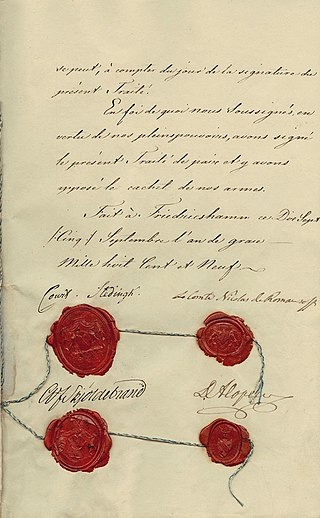
The Treaty of Fredrikshamn, or the Treaty of Hamina, was a peace treaty concluded between Sweden and Imperial Russia on 17 September 1809. The treaty concluded the Finnish War and was signed in the Finnish town of Hamina. Russia was represented by Nikolay Rumyantsev and David Alopaeus, while Sweden by Infantry General Kurt von Stedingk and Colonel Anders Fredrik Skjöldebrand.
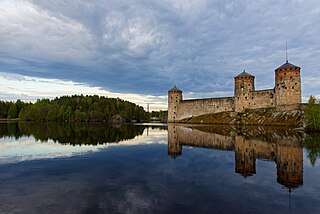
Olavinlinna, also known as St. Olaf's Castle, is a 15th-century three-tower castle located in Savonlinna, Finland. It is built on an island in the Kyrönsalmi strait that connects the lakes Haukivesi and Pihlajavesi. It is the northernmost medieval stone fortress still standing. The castle forms a spectacular stage for the Savonlinna Opera Festival, which was held for the first time in the summer of 1912.
Helsinki is the capital of Finland and is its largest city. It was founded in the Middle Ages to be a Swedish rival to other ports on the Gulf of Finland, but it remained a small fishing village for over two centuries. Its importance to the Swedish Kingdom increased in the mid-18th century when the fortress originally known as Sveaborg was constructed on islands at the entrance to the harbor. While intended to protect Helsinki from Russian attack, Sveaborg ultimately surrendered to Russia during the Finnish War (1808-1809), and Finland was incorporated into the Russian Empire as part of the Treaty of Fredrikshamn. Russia then moved the Finnish capital from Turku to Helsinki, and the city grew dramatically during the 19th century. Finnish independence, a civil war, and three consecutive conflicts associated with World War II made Helsinki a site of significant political and military activity during the first half of the 20th century. Helsinki hosted the Summer Olympic Games in 1952, was a European Capital of Culture in 2000, and the World Design Capital in 2012. It is considered a Beta Level city by the Globalization and World Cities Research Network (GaWC), according to their 2012 analysis.

Nyenschantz was a Swedish fortress at the confluence of the Neva River and Okhta River, the site of present-day Saint Petersburg, Russia. Nyenschantz was built in 1611 to establish Swedish rule in Ingria, which had been annexed from the Tsardom of Russia during the Time of Troubles. The town of Nyen, which formed around Nyenschantz, became a wealthy trading center and a capital of Swedish Ingria during the 17th century. In 1702, Nyenschantz and Nyen were conquered by Russia during the Great Northern War, and the new Russian capital of Saint Petersburg was established here by Peter the Great the following year.
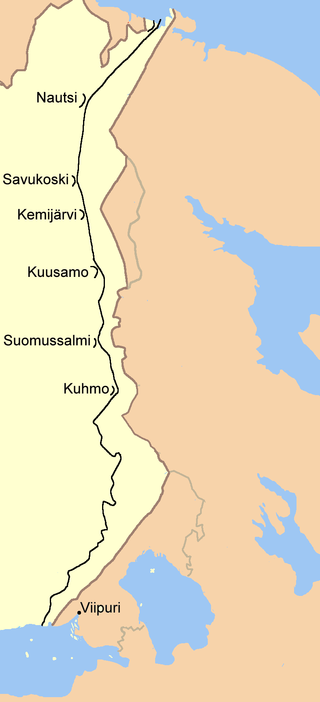
The Salpa Line, or its official name, Suomen Salpa, is a bunker line on the eastern border of Finland. It was built in 1940–1941 during the Interim Peace between the Winter War and the Continuation War and further in 1944 to defend Finland against a possible Soviet invasion.

Kronstadt is a Russian port city in Kronshtadtsky District of the federal city of Saint Petersburg, located on Kotlin Island, 30 km (19 mi) west of Saint Petersburg, near the head of the Gulf of Finland. It is linked to the former Russian capital by a combination levee-causeway-seagate, the St Petersburg Dam, part of the city's flood defences, which also acts as road access to Kotlin island from the mainland.

Kymenlaakso is a region in Finland. It borders the regions of Uusimaa, Päijät-Häme, South Savo and South Karelia and Russia. Its name means literally The Valley of River Kymi. Kymijoki is one of the biggest rivers in Finland with a drainage basin with 11% of the area of Finland. The city of Kotka with 51,000 inhabitants is located at the delta of River Kymi and has the most important import harbour in Finland. Other cities are Kouvola further in the inland which has after a municipal merger 81,000 inhabitants and the old bastion town Hamina.

Turku Castle is a medieval structure in the city of Turku, Finland. Together with Turku Cathedral, the castle is one of the oldest buildings still in use in Finland. It is also the largest surviving medieval building in Finland. It was founded in the late 13th century and stands on the banks of the Aura River. The castle served as a bastion and administrative center in the region of Finland until the early 19th century. It played a role in power struggles within Sweden and the Kalmar Union and stood sieges, with additional battles fought outside its walls. The castle was at its peak in the mid-16th century during the reign of Duke John of Finland and Catherine Jagellon. It lost its status as an administrative center in the 17th century, after Per Brahe's period as governor-general of Finland came to an end. Turku Castle is Finland's most visited museum. Visitations reach well over 100,000 people annually. Some of the rooms in the castle are used for municipal functions.

Häme Castle or Tavastia Castle is a medieval castle in Tavastia Proper, Finland. It is located in Hämeenlinna, the city between Helsinki and Tampere. Originally located on an island, the castle now sits on the coast of lake Vanajavesi. The castle consists of a central keep and surrounding curtain walls, enclosed by a moat. The keep originally had five turrets, but only two are apparent today. The curtain wall has a gatehouse, battlements, an octagonal brick corner turret, and a round gun turret. The lower tiers of the keep and curtain wall are of masoned granite and the upper tiers are red brickwork.
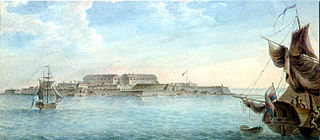
The Svartholm fortress was built between 1749 and 1764 outside Loviisa in Southern Finland by Augustin Ehrensvärd. The fortress, which lies at the mouth of the Bay of Loviisa, along with the planned land fortress at Loviisa, would have prevented invading Russian forces from entering what was then Swedish territory in present-day Finland.

Viipuri Province was a historical province of Finland from 1812 to 1945.

Kyminlinna is a fortress located in the northern part of island of Hovinsaari in Kotka, on the south coast of Finland. Kyminlinna is part of the South-Eastern Finland fortification system built by Russia after the Russo-Swedish War of 1788-1790. Kyminlinna formed the northern part of a double fortification, together with Ruotsinsalmi sea fortress, where Kyminlinna was intended to repulse land-based attacks along the King's Road.

South-Eastern Finland fortification system is an extensive defensive system formed by three concentric fortress chains in South-East Finland built by Russia in the 1790s. The purpose of the fortification system was to protect the capital of the Russian Empire, Saint Petersburg, from a possible Swedish attack.
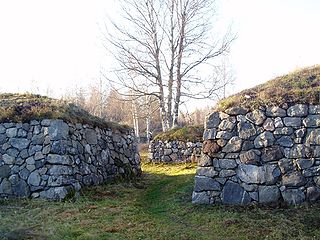
Kärnäkoski Fortress is a bastion fortress in Finland located in Kärnäkoski, Savitaipale built by Russia between 1791 and 1793 to protect Saint Petersburg.

The siege of Viborg took place in the spring of 1710 during the Great Northern War (1700–1721), as a second attempt by the Russians to capture the fortress port of Viborg, near the modern border between Russia and Finland, after a failed attempt in 1706. After the outbreak of the war, Swedish forces had fortified themselves in the port of Viborg. In order to assure safety for the newly founded city of Saint Petersburg, Peter the Great ordered the Swedish fort to be secured. A first unsuccessful attempt was made in 1706. Later plans were put on hold because of other ongoing conflicts but, after the Russian success at the Battle of Poltava in June 1709, the men and resources were available to capture the town.
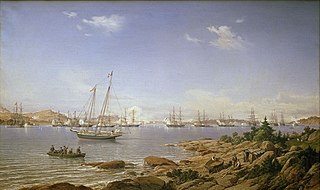
The Åland War was the operations of a Anglo-French naval force against military and civilian facilities on the coast of the Grand Duchy of Finland in 1854–1856, during the Crimean War between the Russian Empire and the allied France and Britain. The war is named after the Battle of Bomarsund in Åland. Although the name of the war refers to Åland, skirmishes were also fought in other coastal towns of Finland in the Gulf of Bothnia and the Gulf of Finland.

The Rampart Field is a pesäpallo stadium located in Hamina, Finland. Since its opening in 1956, it has been the home field of the Haminan Palloilijat, a Superpesis team.






















